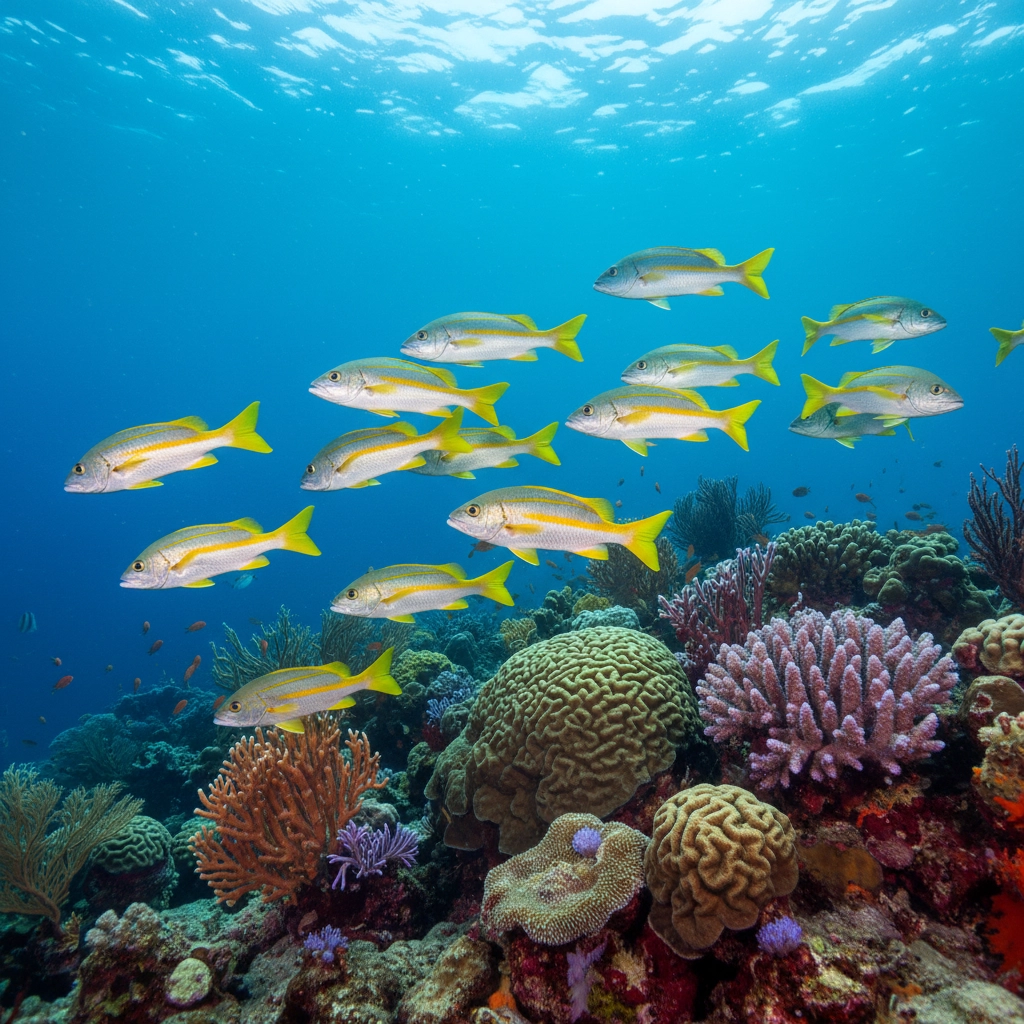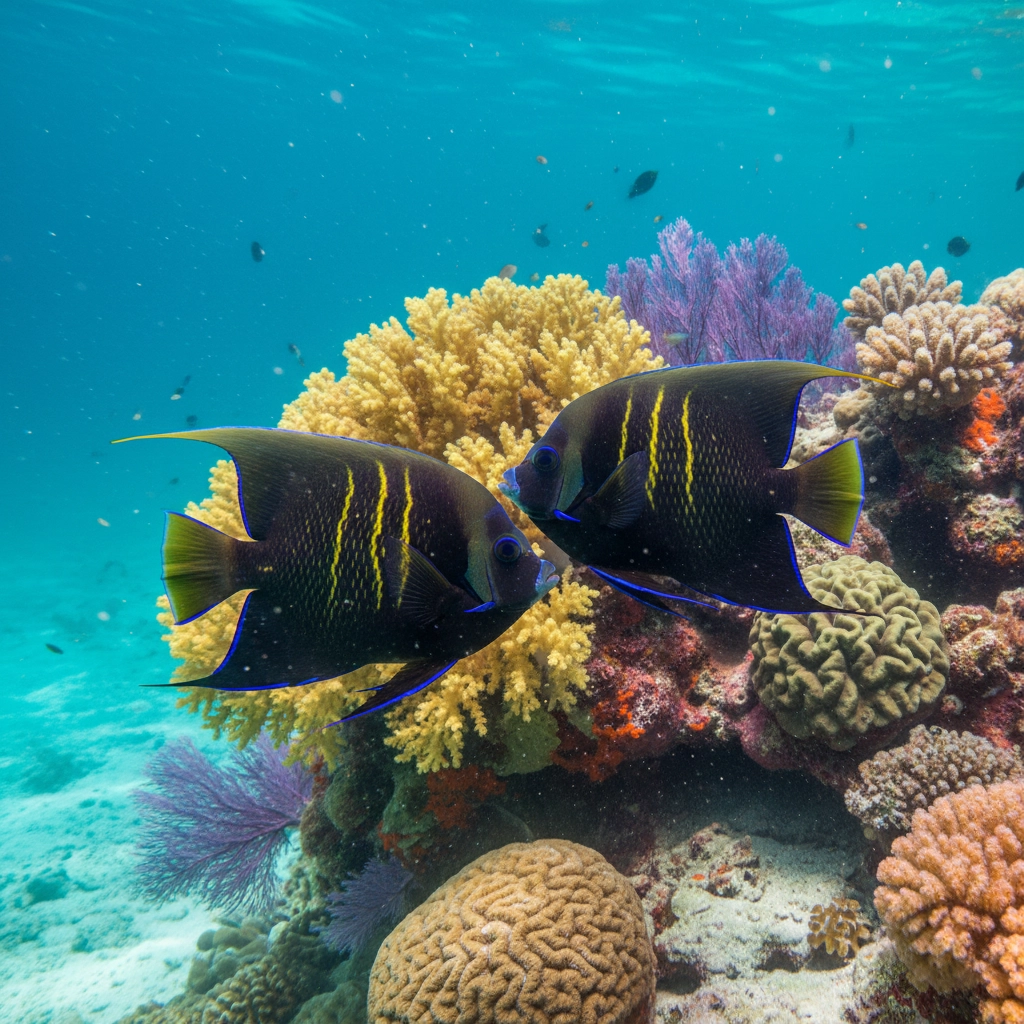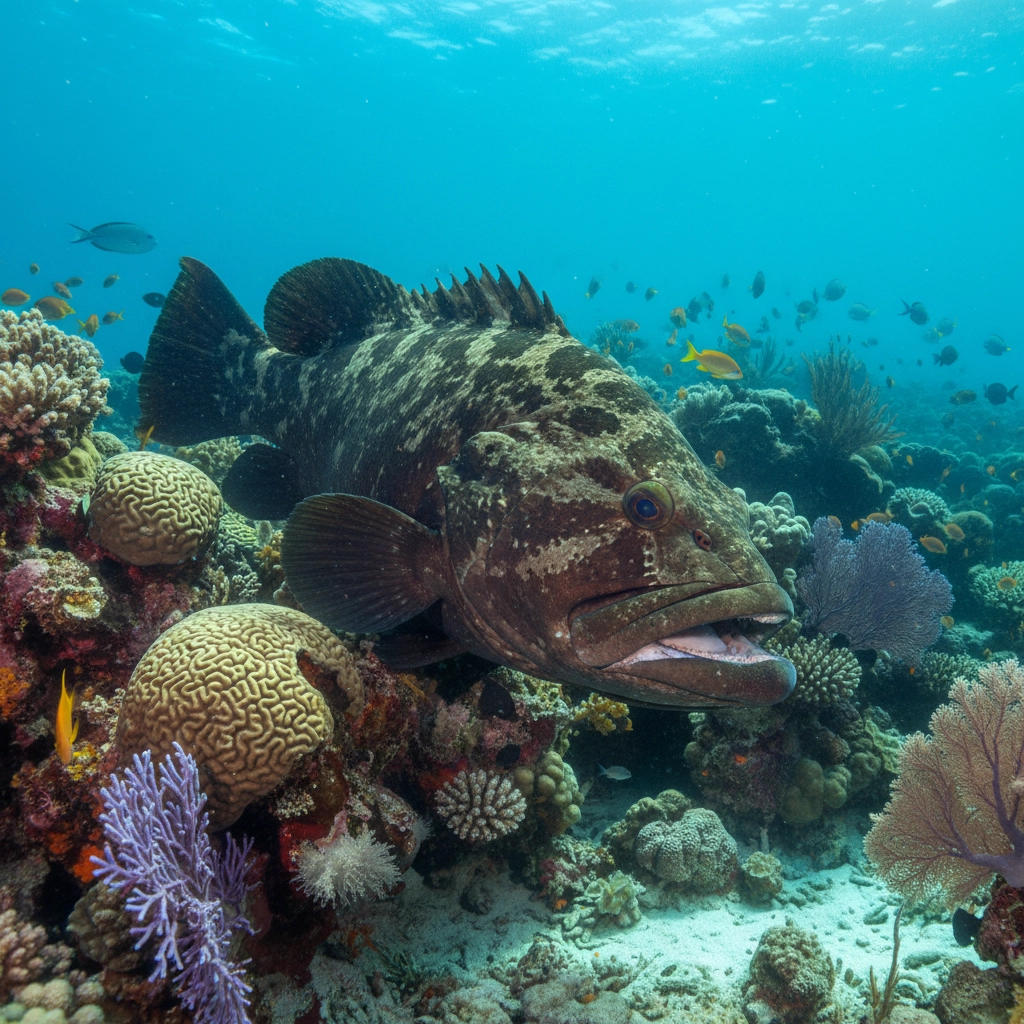Identifying Fish on Florida's Coral Reefs: A Middle School Field Guide (with Mote Marine Reference)
- Caleb Mullenix
- 13 hours ago
- 5 min read
Understanding fish identification on Florida's coral reefs represents one of the most engaging and educational experiences available to middle school students studying marine biology. Florida's coral reef system hosts approximately 600 fish species, making it the third-largest coral reef system in the world and an exceptional outdoor classroom for young marine scientists.
Why Fish Identification Matters for Student Scientists
Developing fish identification skills provides students with direct insight into reef ecosystem health, biodiversity patterns, and marine conservation needs. When students can recognize and categorize reef fish, they gain practical understanding of how different species contribute to coral reef functionality: from algae-eating parrotfish that maintain coral health to cleaner wrasse that provide essential services to other fish species.
Mote Marine Laboratory's research emphasizes that fish identification serves as a gateway to understanding complex marine relationships. Their studies demonstrate how different fish families occupy specific ecological niches, creating the intricate web of relationships that sustain Florida's coral reef ecosystems.
Major Fish Families: Essential Species for Student Identification
Snapper Family: The Reef's Abundant Residents

Snappers represent one of the most commonly encountered fish families on Florida's reefs, making them ideal species for beginning student identification. The yellowtail snapper displays distinctive characteristics that make field identification straightforward: a bright yellow stripe running from nose to tail, silver-blue body coloration, and the characteristic forked tail that gives this species its name.
Gray snappers, also called mangrove snappers, demonstrate remarkable adaptation capabilities. Students should observe how these fish can rapidly change their body coloration depending on water clarity and environmental conditions. The dark band running through their eye can lighten or darken as a predation deterrent: a fascinating behavioral adaptation that captivates young observers.
Schoolmaster snappers provide an excellent memory aid for students: their bright yellow fins match "the color of a school bus," making field identification both educational and memorable. These snappers typically aggregate in small groups around coral formations, allowing students multiple observation opportunities during reef exploration activities.
Parrotfish: The Reef's Maintenance Crew
Parrotfish earn recognition as essential reef ecosystem engineers, and their identification provides students with direct understanding of coral reef maintenance processes. These colorful fish use their beak-like mouths to scrape algae from coral surfaces, producing the characteristic crunching sounds that students can hear while snorkeling.
The stoplight parrotfish exhibits dramatic color variations between juvenile and adult phases, offering students opportunities to observe life cycle adaptations in real-time. Terminal phase males display vibrant green and blue coloration with distinctive markings, while initial phase fish show more subdued yellow and red patterns.
Rainbow parrotfish represent another easily identifiable species, with their distinctive rainbow-colored scales creating unmistakable field identification markers. Students can observe how these fish contribute to sand production: each parrotfish can produce up to 200 pounds of sand annually through their feeding activities.
Angelfish: Elegant Reef Ambassadors

Angelfish families provide excellent subjects for teaching students about territorial behavior and reef habitat preferences. French angelfish display striking black and yellow striped patterns that remain consistent across age groups, making them reliable identification targets for beginning marine biology students.
Gray angelfish demonstrate how fish adapt to different reef zones, with juveniles often observed in shallow seagrass beds while adults prefer deeper coral formations. Students can track these habitat preferences during field studies, developing understanding of fish life cycle requirements.
Queen angelfish represent the most spectacular angelfish species in Florida waters, with their brilliant blue and yellow coloration and distinctive crown-like markings. These fish often allow close observation, providing excellent photography opportunities for student documentation projects.
Butterflyfish: Colorful Reef Indicators
Butterflyfish species serve as important reef health indicators, making their identification particularly valuable for student conservation education. The four-eye butterflyfish displays characteristic false eyespots that confuse predators: a perfect example of evolutionary adaptation that engages student interest in natural selection concepts.
Spotfin butterflyfish feature distinctive white bodies with yellow fins and prominent dorsal fin spots, creating easily recognizable identification patterns. These fish often travel in pairs, demonstrating monogamous behavior that provides opportunities for discussing fish social structures with students.
Banded butterflyfish show striking black and white vertical stripes that serve as both species identification markers and camouflage mechanisms among coral formations. Students can observe how these patterns help fish blend with coral shadows and reef structures.
Grouper Species: Apex Predators of the Reef

Grouper identification introduces students to reef predator relationships and fishing industry connections. Nassau grouper, though less common due to overfishing pressures, display remarkable color-changing abilities that demonstrate fish communication and behavioral adaptation.
Black grouper represent more commonly observed species, with their mottled brown and black patterns providing excellent camouflage among coral formations. Students can observe grouper hunting behaviors and territorial defense strategies during reef exploration activities.
Goliath grouper encounters, while rare, provide unforgettable educational experiences. These massive fish, which can exceed 400 pounds, demonstrate the importance of marine protected areas and conservation success stories.
Grunt and Wrasse Families: Supporting Cast Members
French grunts create distinctive aggregations around coral heads, providing students with opportunities to observe schooling behavior and predator avoidance strategies. Their yellow and blue striped patterns make individual identification possible while demonstrating group dynamics.
Bluehead wrasse exhibit fascinating sex-change capabilities, with individuals transforming from yellow females to blue-headed males based on social and environmental factors. This species provides excellent opportunities for discussing fish reproduction strategies and population dynamics.
Appleseed Expeditions Field Integration: Hands-On Learning Applications
Appleseed Expeditions incorporates fish identification activities throughout Florida Keys programs, providing students with structured observation opportunities that reinforce classroom learning. During snorkeling sessions, students use waterproof identification cards to document species observations, creating personal field logs that track biodiversity patterns across different reef sites.
Photography assignments encourage students to capture high-quality images of identified species, developing both technical photography skills and detailed observation capabilities. These images become valuable resources for post-trip analysis and presentation development.
Fish behavior documentation activities teach students to observe and record feeding patterns, territorial behaviors, and interspecies interactions. Students learn to recognize cleaning stations where wrasse provide services to larger fish, predator-prey relationships, and territorial defense strategies.
Mote Marine Laboratory Research Integration
Mote Marine Laboratory's ongoing fish population studies provide real-world context for student identification activities. Their research demonstrates how climate change, pollution, and habitat degradation affect fish community composition, connecting student observations to broader conservation challenges.
Fish tagging and monitoring programs conducted by Mote Marine Laboratory illustrate how scientists track fish movement patterns and population health. Students learn about research methodologies and data collection techniques that support marine conservation efforts.
Spawning aggregation research conducted by Mote Marine scientists shows how certain fish species gather in specific locations during reproduction periods, providing opportunities for students to understand fish life cycles and conservation timing requirements.
Practical Identification Strategies for Student Success
Begin fish identification by observing overall body shape and size, progressing to color patterns and distinctive markings. Students should focus on easily recognizable features such as fin coloration, body stripes, and unique anatomical characteristics before attempting more detailed species distinctions.
Develop systematic observation techniques that include noting fish behavior, habitat preferences, and group dynamics. Students should record whether fish are solitary, paired, or schooling, as these behavioral patterns provide important identification clues.
Use comparative identification methods that group similar species together, highlighting distinguishing characteristics that separate closely related fish. Students can create comparison charts that illustrate differences between similar species such as various snapper or angelfish species.
Practice with common species first, building identification confidence before progressing to less frequently encountered fish. Students should master abundant species identification before attempting to identify rare or uncommon reef fish.
More Detailed Fish Identification Photos
For more detailed fish identification photos, check out Mote Marine Laboratory's Animal Encyclopedia at https://mote.org/animal-encyclopedia/. Students can view pictures and information for snapper, grouper, angelfish, parrotfish, wrasse, grunts, and other common Florida coral reef fish species. Encourage students to use this online archive to compare and identify fish spotted during their Appleseed Expeditions field activity.
Through structured fish identification activities integrated with Mote Marine Laboratory research and Appleseed Expeditions field programs, middle school students develop both marine biology knowledge and practical conservation awareness. These identification skills provide the foundation for lifelong appreciation of marine ecosystem complexity and conservation responsibility, preparing students to become informed ocean advocates and future marine scientists.



Comments